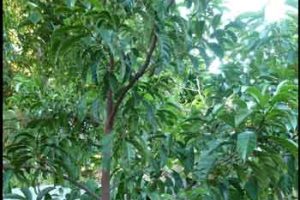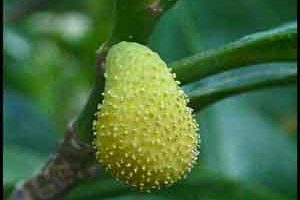Artocarpus hypargyraeus
Kwai muk
Origin
Native to China and not very widely known around the world apart from collectors.
Climate
Sub-tropical. Can be damaged by frosts and sub-zero temperatures may kill the tree.
Plant Description
It is a slow-growing, small evergreen tree. The canopy is compact, with beautiful glossy green leaves that would earn it a place in many gardens.
Relatives
Belongs to the Moraceae Family, related to jakfruit, breadfruit, mulberries and figs.
Soils
Preference for well-drained, mildly acid soil. It can survive brief flooding.
Propagation
Propagation is largely by seeds.
Cultivars
There are no widely recognised varieties.
Flowering and Pollination
It is monoecious but relatively self-sterile, with isolated trees setting many small seedless fruit.
Cultivation
Give water during extended dry spells. Grow in full sun, or very lightly shaded. May need foliar sprays of zinc and manganese and soil application of iron chelates.
Wind Tolerance
Reasonable.
Pruning
Prune only to remove dead branches, and to decrease the height or width of the tree.
The Fruit
Fruit size, normally 5-7cm in diameter, depending on the effectiveness of pollination; similarly fruit shape can be irregular if pollination is only partial. Like the jackfruit, the fruit is a syncarp. When ripe, skin colour is yellow and pulp is orange with a pleasant sub-acid flavour. Fruit must be completely ripe as unripe fruits produce white, sticky latex. Ripening happens quickly, in 1 to 3 days.
Fruit Production and Harvesting
Yield can be up to 2000 fruits per tree under ideal conditions. Pick only when fully ripe. Fruits mature in autumn.
Fruit Uses
Eaten fresh. Pulp can be used for desserts and baking.
Pests and Diseases
None observed.
Comments
An attractive tree, good fruit, worthy of garden space.
More Information
The following comments were prompted by some discussion in our Facebook group concerning flowering and fruit set in this species. Jackfruit (A heterophyllus) is the most commercially important fruiting species in the genus, and accordingly it’s been the one that has been the subject of most horticultural research. Far less is known about other edible species, eg chempedak (A integer), breadfruit (A altilis) and marang (A odoratissimus), with even less for kwai muk, despite the fact that it’s a threatened species in its native area of southern China. The few studies that have been published are mostly in Mandarin and consequently have not been widely disseminated or subject to international peer review.
There are about 50 Artocarpus species and are all monoecious ie individual trees have separate unisexual male and female flowers. Kwai muk inflorescences are yellowish, axillary and solitary. The obovoid male head consists of numerous flowers on a 10-23mm long peduncle, and at anthesis is 15-20 X 10-15 mm with pubescent tetramerous proximally-free perianth (sepals and petals) segments that are about 1 mm long. Each flower has a single 1-1.5 mm long stamen. The female head contains numerous flowers and is about 2cm across, with pubescent protruberances (papillae) formed from inter-floral bracts; ex-serted styles protrude about 0.5 mm between the papillae. Fruit, 2-4cm across on a 35-50mm long peduncle with up to a dozen fruiting carpels, is a pubescent sub-globose syncarp with the papillae still mildly apparent, and has a milky latex when unripe, green maturing to yellow-apricot coloured skin, orange-reddish flesh and zero to several seeds.
Insects are believed to be the major pollinators. Pollination is facultatively xenogamous, ie the major means of pollination is by outcrossing with a genetically different tree of A hypargyreus while it has limited means of being pollinated by pollen from male flowers on the same tree provided sufficient overlap of male and female flowering occurs. Different trees can have variable levels of sterile pollen. In other edible Artocparpus species it has been found that fruit set may occur but only after pollination, leading to seedless fruit. Kwai muk is genetically highly heterozygous and some trees are triploid, leading to difficulties in cross pollination with other diploid plants. For chempedak in south east Asia, a complex pollination mechanism has been found involving gall midges and fungi.
A hypargyreus is not a common fruit tree species in Australia and the chance of Nursery mislabelling is considerable. The above information on flower morphology, which plays a major role in plant identification, might help you confirm that your plant is what is claimed. And as far as research on the species goes, it seems that for good cropping it would be best to have more than a single tree, or to achieve the same effect though grafting.

